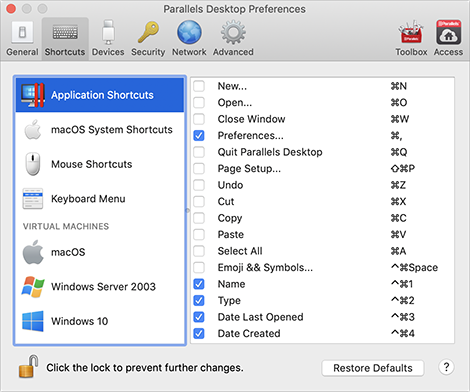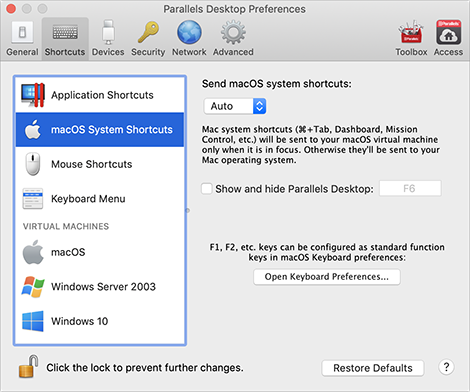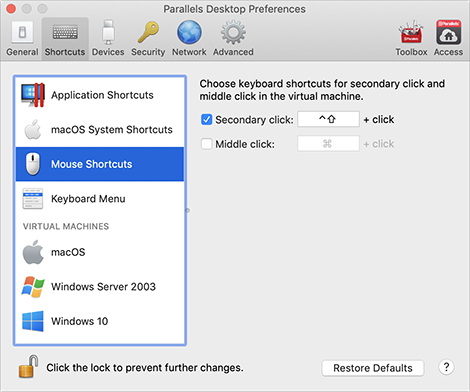Shortcuts Preferences
Use Shortcuts Preferences to customize keyboard shortcuts, create keyboard profiles for multiple operating systems, enable or disable macOS system shortcuts, and more.
To open these preferences, choose Parallels Desktop > Preferences, then click Shortcuts.
Application Shortcuts

You can perform various actions in Parallels Desktop either by choosing menu items from the corresponding menus or by pressing key combinations. For example, you can open an existing virtual machine either by clicking File > Open or by pressing Command + O. However, if you deselect this key combination, the shortcut will not work.
To customize which actions can be performed by pressing key combinations, do the following:
- Choose Application Shortcuts on the Shortcuts tab.
- Enable or disable actions that can be performed by pressing key combinations.
macOS System Shortcuts

In macOS the function keys on your keyboard (F1, F2, F3 and so on) control functions like activating Dashboard and Mission Control, adjusting screen brightness, and controlling the volume. By default, when a Windows application is active the function keys and other Mac system shortcut key combinations (such as pressing Cmd + Tab to switch between open applications) continue to activate macOS functions.
To set whether function keys and macOS system shortcut key combinations activate functions in macOS or Windows:
- Choose macOS System Shortcuts on the Shortcuts tab.
- Select one of the following from the Send macOS system shortcuts menu:
- Auto: If you're working with Windows, system shortcuts that don't function in Windows (for example, Control-Up Arrow button to display Mission Control) trigger functions in macOS. If you're using macOS as a guest OS and a guest OS or its application is active, system shortcuts that are typical only to macOS trigger functions in the guest version of macOS.
- Always: When Windows or Windows applications are active, function keys and other system shortcuts always trigger functions in Windows.
- Never: Function keys and other system shortcuts always trigger functions in macOS.
To show and hide Parallels Desktop, use the Fn + F6 key combination. To use any other key instead of F6, click the corresponding text field and press the key you want.
Mouse Shortcuts

Many tasks in Windows, such as bringing up shortcut menus, are accomplished by right-clicking. By default, Parallels Desktop is set to mimic a right-click when you press Shift+Control and click the mouse. You can change which key combination triggers a right-click. Do the following:
- Choose Mouse Shortcuts on the Shortcuts tab.
- Select Secondary click (for right-click) or Middle click.
- Click in the corresponding text field and press the key or combination of keys that you want to use with a mouse click to trigger a right-click or middle-click.
You can use any combination of the Control, Option (Alt), Shift, and Command keys.
Keyboard Menu

While working with a virtual machine, you can enter key combinations by choosing Devices in the macOS menu bar > Keyboard and then choosing a key combination. To customize available key combinations, do the following:
- Choose Keyboard Menu on the Shortcuts tab.
- Do one of the following:
- To add a new key combination, click the Add button
 .
. - To remove a key combination from the Keyboard menu, select it and click the Remove button
 .
. - To edit an existing key combination, double-click the key combination or select it and click the Edit button
 . Click modifier keys to select or deselect them. If you wish, change the character in the text field.
. Click modifier keys to select or deselect them. If you wish, change the character in the text field.
- To add a new key combination, click the Add button
Virtual Machine Shortcuts

By default, Parallels Desktop maps common macOS keyboard shortcut key combinations to the equivalent Windows key combinations. That way if you're used to, for example, pressing Command-C to copy text in macOS, you don't have to switch to the Windows equivalent, Control-C.
To customize keyboard shortcuts, do the following:
- Select your virtual machine from the VIRTUAL MACHINES list on the Shortcuts tab. When you're using a Windows application, pressing a key combination in the From macOS column above triggers the key combination in the To Windows column.
- If the lock icon is locked, click it and enter an administrator password.
- Do one of the following:
- To edit an existing key combination, double-click the key combination or select it and click the Edit button
 . Click modifier keys to select or deselect them. If you wish, change the character in the text field.
. Click modifier keys to select or deselect them. If you wish, change the character in the text field.
Click OK to save the changes.
- To delete a key combination, select it and click the Remove button
 .
. - To add a new key combination, click the Add button
 .
.
- To edit an existing key combination, double-click the key combination or select it and click the Edit button